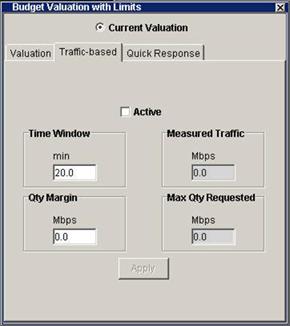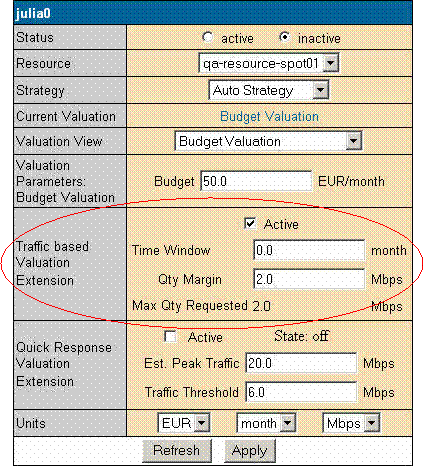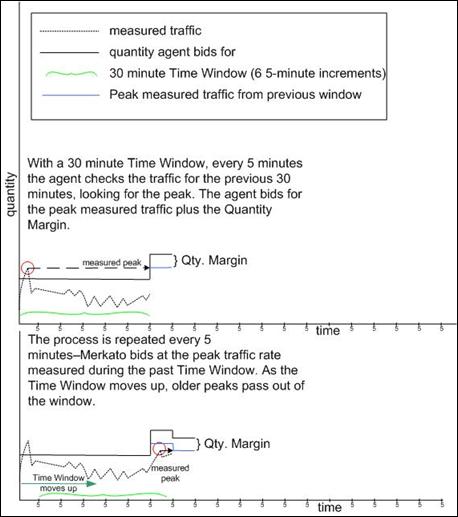
With Traffic-based bidding enabled, your agent changes its maximum quantity according to changes in rates of usage. You set the frequency with which Merkato automatically aligns your bidding with your utilization.
Note:Traffic-based bidding controls are only available if they are enabled for your agent by the Merkato administrator.
In the Desktop interface, each valuation window has a Traffic-based tab. To activate Traffic-based bidding, click the Active check box.

In the Express interface there is a Traffic-based panel. To activate Traffic-based bidding, click the Active check box.

Time Window¾The Measurement Window. Your agent continuously measures the amount of traffic you generate in five-minute increments. The Time window setting tells the agent, in minutes, how far back in time to look for the peak. The smallest interval you can select is 6 minutes. Unless your Merkato administrator has changed this, the largest allowed interval is 200 minutes (in other words, the peak of the last 40 5-minute traffic samples).
Meas. Traffic¾Measured Traffic (Display Only field). The peak amount of traffic the agent has measured at the interval you set in the Meas. Window field. This information is only available in the Desktop interface. Merkato uses this peak five-minute interval as the basis for the “Max Quantity Requested” calculation. (See below.)
Qty Margin¾Quantity Margin. This is the amount of bandwidth your agent attempts to obtain above that of the recent measured peak. There are many reasons why you might want to obtain more bandwidth than your recent measured peak. The most significant reason is that you will not be able to measure peak traffic above your most recently measured peak if your allocation only allows that amount of traffic to pass through the Merkato system (it becomes a self-fulfilling prediction). Similarly, if your traffic goes to zero for any length of time, your agent would start to ask for zero allocation and you would never be able to increase your allocation beyond this value. Set your Quantity Margin to the maximum expected jump of traffic within a five-minute period.
Max Qty Requested¾Maximum Quantity Requested (Display Only field). The Merkato agent adds the measured traffic to the Quantity Margin to create this number. This is the value that is carried forward into the main valuation calculation. It is called the “Maximum Quantity Requested” because Merkato compares to the “Max Qty” value in the main valuation window. Merkato uses whichever value is smaller as the basis for the maximum quantity requested. (In other words, traffic-based settings can only reduce the amount of bandwidth you ask for relative to the main valuation settings--they never increase it.) Note that the “Max Qty Requested” value only changes the initial bidding point. Should your offered bid price be insufficient to get that amount of bandwidth, your agent may use your pre-determined valuation curve below that value (unless you are using a linear valuation) to attempt to obtain as much bandwidth as possible.
Active check box¾Checking this box enables Traffic-based bidding for your agent.
Apply¾Clicking Apply makes the numbers entered in the fields of the Traffic-based window active.
In the illustration the traffic window is set to 30 minutes. The agent bids for the quantity of bandwidth used during peak traffic during the previous 30 minutes. Every five minutes the agent examines the traffic during the previous 30 minute window.

Traffic-based valuation sets the amount of bandwidth the agent bids for to the amount of traffic Merkato detects for the buyer. The Quantity Margin is an amount of bandwidth added to the rate of traffic detected. For example, if Merkato detects 5 Mbps for the buyer, and the Quantity Margin is set to 2 Mbps, the agent bids for 7 Mbps.
Despite the fact that bidding quantity is tied to measured traffic, allocated capacity doesn’t always match the current rate of traffic. When traffic increases or decreases, there is a lag between when the agent changes the quantity of its bid and the end of the auction, when Merkato makes the allocation to the buyer. The purpose of the Quantity Margin is to ensure that the buyer has enough capacity to accommodate increases in traffic before the buyer receives its next allocation. For example, if the buyer’s traffic increases from 5 Mbps to 8 Mbps just after an auction ends, the buyer can’t receive in increased allocation until the end of the next auction. However, if the buyer has set the agent’s quantity margin to 3 Mbps, when traffic is at 5 Mbps the agent bids for 8 Mbps. This allows a margin to accommodate spikes in traffic.
You may want to guarantee a minimum level of bandwidth but still allow for spikes in traffic. Merkato lets you guarantee bandwidth by buying reservations. But a buyer agent in the Spot market does not know of Reservations made for the same buyer in the Reservations market. If you use Traffic-base valuation, you can use a negative Quantity Margin to subtract your guaranteed bandwidth from the amount your agent bids for.
Suppose, for example, you have a reservation for 5 Mbps for a day. But you want to ensure that, if traffic exceeds 5 Mbps, your agent will bid for additional bandwidth. You could enable Traffic-based valuation and set the Quantity Margin to -5 Mbps. In this case, if Merkato measured traffic for the buyer at 9 Mbps, the agent would subtract 5 Mbps and bid for 4 Mbps. (A better idea might be to set the Quantity Margin to -3 Mbps, to accommodate 2 Mbps spikes in traffic.)